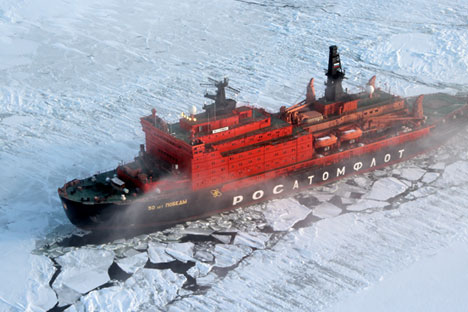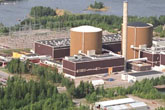Floating nuclear power stations may fend off energy crises

With nine nuclear-powered icebreakers, Russia’s fleet is the world’s strongest. Source: ITAR-TASS
The main task of the IAEA General Conference that is taking place at the moment is to set out specific plans for the development of the nuclear power industry on a global scale. “We expect the conference to help set specific targets for the roll-out of new technology in the areas on nuclear power generation and nuclear safety”, Russia’s Permanent Representative to Vienna-based international organization Vladimir Voronkov said. These include, among other things, nuclear technology in the ocean environment – a key subject of Russian research into the use of nuclear energy sources.
The idea to use nuclear power on the water first became viable in the mid-1950s. The first commercial passenger/freight vessel, the Savannah, built under President Eisenhower’s special program, was launched in the United States in 1962. Yet all American, German, and Japanese initiatives in this area eventually failed.
In the USSR, on the other hand, the right niche was carved out for nuclear-powered commercial vessels that generated substantial returns. Besides, implementation of the principle of colossal concentration of energy onboard commercial vessels acted as testing grounds for the development of nuclear-powered engines for Navy submarines and warships.
The ability to sail autonomously for long periods of time pointed to an appropriate region to operate such vessels – the Arctic. It’s in the Polar Regions that nuclear-powered engines demonstrate their advantages, because icebreakers continuously have to operate at full throttle. Icebreakers remain at open sea for a long time between port calls, since leaving the route to refuel would result in heavy losses.
The world’s first commercial icebreaker, the Lenin, was built in 1957. It had a lot of advantages over conventional ships, and became the first surface vessel in history to pass north of Novaya Zemlya in 1971.
With nine nuclear-powered icebreakers, Russia’s fleet is the world’s strongest. Nuclear-powered icebreakers have turned the Northern Sea Route into a well-traveled artery supporting year-round navigation in the West Arctic.
That said, a nuclear-powered icebreaker fleet is far from the only thing Russia’s nuclear power industry is capable of. While renewable energy as a means to stave off an energy crisis is still far from finding an efficient industrial implementation, a solution to this problem could be found in the nuclear sphere.
One promising idea involves floating nuclear power plants that Russia was first to decide building. The idea was actively debated in other countries too, but has been turned down – mainly because of the opposition from the greens.
Construction on the first floating nuclear power plant, the Academic Lomonosov, started in 2009. According to the CEO of the state owned corporation Rosatom Sergei Kirienko, “we already have prospective international customers, but they want to see how the pilot project is implemented”.
The floating nuclear power plant is an engineless vessel with two reactors onboard. It can be used to generate electric power and heat and also to desalinate seawater. Its service life is estimated at no less than 36 years – three cycles of 12 years each, with reactor reloading in between. The crew, including replacement and reserve headcounts, numbers around 140.
Construction and operation of such power plants is estimated to be much cheaper than conventional power plants, which should guarantee strong demand. Besides exports, floating power units will become powerful sources of electricity, heat, and freshwater for Russia’s remote regions.
But safety is the main reason behind nuclear projects’ success. Since the project is based on tremendous experience operating icebreakers and submarines, the degree of its safety is very high. According to experts, facilities of this kind are the world’s most reliable today.
In general, floating nuclear power plants could become a unique national project; if they are successful, Russia will remain the leading global energy supplier.
All rights reserved by Rossiyskaya Gazeta.
Subscribe
to our newsletter!
Get the week's best stories straight to your inbox

